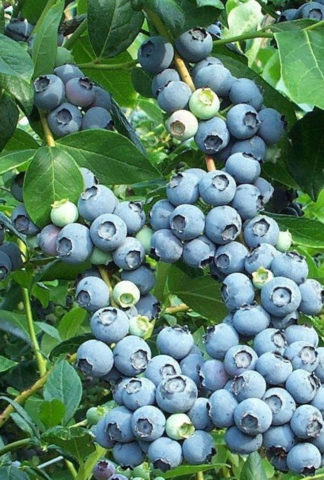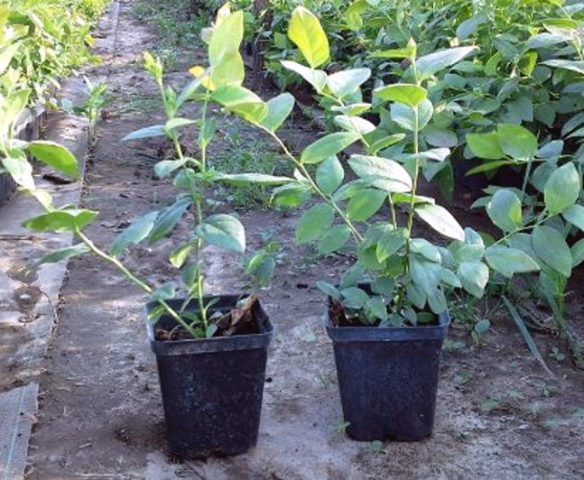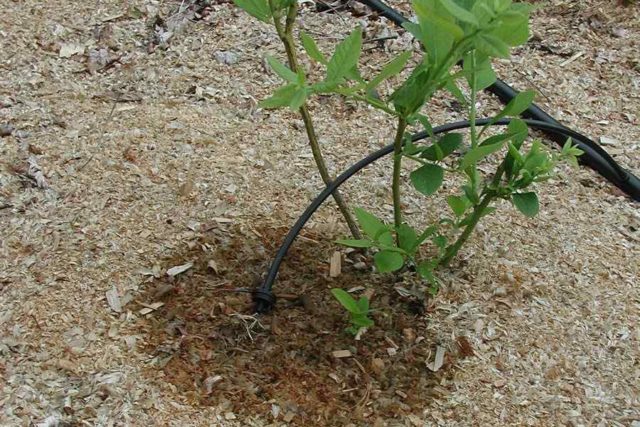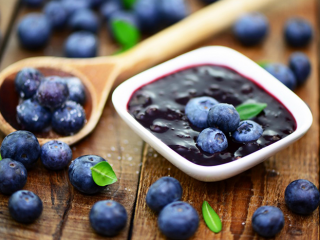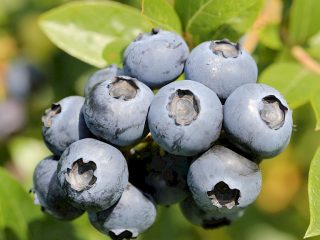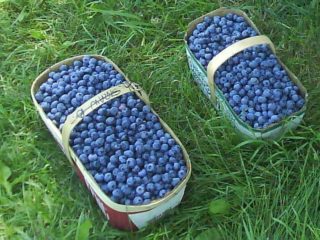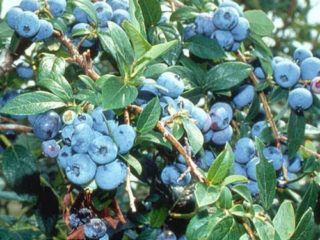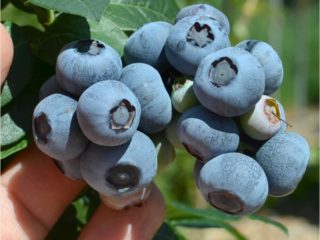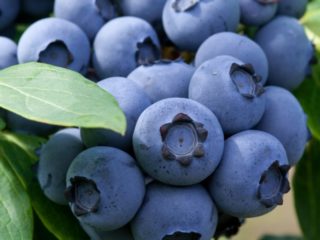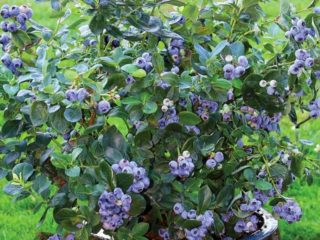Content
Blueberry Goldtraube 71 was bred by the German breeder G. Geerman. The variety was obtained by crossing the American varietal highbush blueberry with the low-growing narrow-leaved species V. Lamarkii. Blueberry Goldtraube 71 is not included in the Russian State Register.
Description of blueberry variety Goldtraube 71
Blueberry Goldtraube 71 is a deciduous fruit shrub of the Ericaceae family. As an adult, it forms a spreading bush with a well-developed root system. If agricultural practices are followed, it reaches a height of 2 m.
From the photo of Goldtraube blueberry 71 you can see that the leaves of the bush are bright green and oval in shape. In autumn, the foliage changes color to red. The shrub blooms from mid-summer with bell-shaped flowers, white or pale pink.
The description of the Goldtraube 71 blueberry indicates that the variety is suitable for growing in container culture. It has increased frost resistance and belongs to the 4th winter hardiness zone.Without shelter, it can withstand temperatures down to -32°C.
Features of fruiting
Blueberry Goldtraube 71 is a self-pollinating variety. The bush can be planted singly. But with the possibility of cross-pollination with blueberries of other varieties, the yield increases.
The berries of the variety are light blue, round, 16 cm in diameter, collected in dense clusters. The weight of one berry is 1.9 g. The yield of the variety is average - 2.5-3 kg per adult bush. The crop begins to bear fruit in early August. The taste of the berries is sweet and sour.
Berries of the Goldtraube 71 variety are consumed fresh, used as a filling for pies and prepared in the form of jams and preserves.
Advantages and disadvantages
Blueberry bush Goldtraube 71 looks decorative throughout the warm period of the year. The advantages of the variety also lie in its high adaptation to cold climates. The Goldtraube 71 variety is unpretentious to grow and is suitable for beginner gardeners.
The disadvantages of the Goldtraube 71 variety include its average yield and the presence of sourness in the taste of the berries.
Features of reproduction
To preserve the characteristics of the garden blueberry variety Goldtraube 71, propagation of the shrub is possible only by vegetative means. For reproduction, cuttings or layering methods are used.
For cuttings, material is collected at the end of June from coppice shoots, which take root better than shoots from the fruiting zone. Lignified cuttings are also suitable for propagation. The selected shoots, which are pressed to the soil to obtain planting material, take root for a long time, within 2-3 years.
Planting and care
Blueberries of the Goldtraube 71 variety are demanding on soil acidity. The culture is grown only in an acidic substrate.The soil pH level should be 4.5-5.5. Unsuitable soil at the planting site is completely replaced with acidic soil, using a mixture of pine litter and high red peat.
Recommended timing
Blueberry seedlings are kept in containers until transplantation. The seedling can be left in the container for a long time before planting in the main place.
Young plants with a closed root system are replanted throughout the warm period of the year. Spring planting is preferable; during the summer, the plant has time to take root well and tolerates the first winter better.
Site selection and soil preparation
A permanent place for planting blueberries of the Goldtraube 71 variety is chosen, because an adult bush does not tolerate transplantation well. The best areas are those where no other crops have grown before and where the land has not been developed. Choose a place for the bush that is sunny and protected from strong winds. The depth of groundwater should not exceed half a meter.
When planting in groups, shrubs are planted in rows in a direction from north to south. The distance between bushes in a row is 1.2 m, and between rows - 1.5 m. Goldtraube 71 blueberries do not coexist well with other representatives of heathers, for example, cranberries.
Landing algorithm
The blueberry root system is fibrous and does not go far into the soil. A planting hole for one bush is dug 1 m in size on all sides and 0.5 m in depth. For planting, the peat substrate is mixed with mineral fertilizer in an amount of 20-30 g per 1 square meter. m. A drainage layer of about 5 cm from rotted pine sawdust or bark is poured onto the bottom.
In order for the blueberry bush to take root well in the future, when planting it is especially important to break the earthen ball and free the roots, which, from being in a tight container for a long time, have grown inside the ball.To do this, the container with the seedling is released for 15 minutes. in water.
After soaking, the root system is freed from the soil and the roots are carefully straightened so that they are evenly located in different directions.
Planting a blueberry seedling:
- The plant is planted vertically, the roots are straightened, and buried 5-7 cm from the general soil level. The soil is lightly pressed.
- Plantings are watered abundantly.
- The soil is mulched to a height of 5-8 cm with pine litter.
To prevent the mulch from being washed away by watering, a border tape is installed along the diameter of the planting hole.
Growing and care
When growing blueberries, it is necessary to monitor the moisture and acidity of the soil and keep the planting site free of weeds. Otherwise, according to reviews of Blueberry Goldtraub 71, the variety does not cause any difficulties in care. The annual growth of branches is 50 cm, green foliage and an increase in yield indicate that the shrub is grown correctly.
Watering schedule
Maintaining soil moisture is necessary for the life of mycorrhiza. Drying out the soil leads to the death of the plant.
For the entire period until the seedling takes root, the soil is kept moderately moist. For this, it is best to use drip irrigation. An adult bush is watered several times a week, using 10-15 liters of water per watering. In dry weather, spraying water along the crown is added.
Abundant watering is especially important from mid-summer, during periods of fruiting and the formation of flower buds for the next season's harvest. Despite the crop’s requirement for regular watering, moisture should not be allowed to stagnate at the roots.
Feeding schedule
To fertilize blueberries, only mineral fertilizers are used, which begin to be applied from the second year of cultivation. The first feeding is carried out during the period of bud swelling, the second – after 1.5 months. Do not use manure, bird droppings, humus or ash to fertilize shrubs.
If the required pH level is violated, the shrub loses productivity and the leaves turn pale green. To maintain soil acidity in the spring, add a handful of colloidal sulfur under the bush. Periodically add citric or oxalic acid to the water for irrigation in a ratio of 1 tsp. for 3 liters of water.
Trimming
For blueberry bushes of the Goldtraube 71 variety, only sanitary pruning is carried out. During the spring inspection, very thin and broken shoots are cut off. After 5 years of cultivation, dry, non-fruit-bearing branches, as well as small bushy growths, are removed from the bush.
Preparing for winter
Only young plants are prepared for winter by covering them with spruce branches. Mature bushes tolerate winter well, being under the snow. In areas with little snow, bushes can be covered with spunbond.
Pests and diseases
With proper agricultural technology, blueberries show good resistance to diseases and pest attacks. But with weak immunity and improper care, the plant may be susceptible to fungal infections.
Common pests of shrubs are chafer larvae, leaf rollers and aphids. Delicious berries are eaten by birds.
Conclusion
Blueberry Goldtraube 71 is a fruit shrub, a cultivated form of wild blueberry.If the planting and cultivation characteristics are observed, the shrub brings a good harvest of vitamin-rich berries at the end of summer, when many trees and shrubs have already finished bearing fruit.
